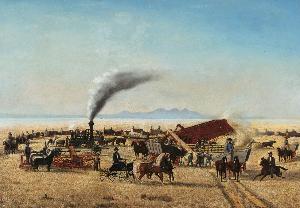Andrew Putnam Hill
Andrew P. Hill;Andrew Putnam Hill
Place: Porter County
Born: 1853
Death: 1922
Biography:
Andrew Putnam Hill was a Californian painter and photographer born in Porter County, Indiana in 1853. He is best known for leading an effort from 1899 to 1902 to save a forest of large redwoods in Big Basin, California, as a public park, the first in what became the California State Park System.
Early Life and Career
Andrew Putnam Hillbegan his career as a painter and photographer, capturing the beauty of the American West. His work was influenced by the Precisionist movement, which emerged in the United States after World War I. This modernist art movement emphasized geometric shapes, eliminated detail, and often used planes of light to create a sense of crisp focus.
Notable Works and Collections
Some of Andrew Putnam Hill's notable works can be found in the Crocker Art Museum (Sacramento, United States), including his painting George W. Hoag. The museum houses an impressive collection of European art from the Renaissance to the 20th century, as well as Asian sculptures and contemporary art.
Awards and Legacy
Andrew Putnam Hill'sefforts to save the Big Basin forest were successful, and he is remembered as a pioneer in the conservation movement. His legacy can be seen in the many parks and protected areas that exist today. Precisionism and Photorealism are also notable art movements that have been influenced by his work.
- Painting by 'Andrew Putnam Hill' | Andrew Putnam Hill:George W. Hoag
- Andrew Putnam Hill | Andrew Putnam Hill was a Californian painter and photographer born in Porter County, Indiana in 1853.
died in Pacific Grove, California in 1922, leaving behind a legacy of beautiful paintings and a lasting impact on the art world. His work can be seen in various museums, including the Crocker Art Museum, and his story is an inspiration to artists and conservationists alike.

